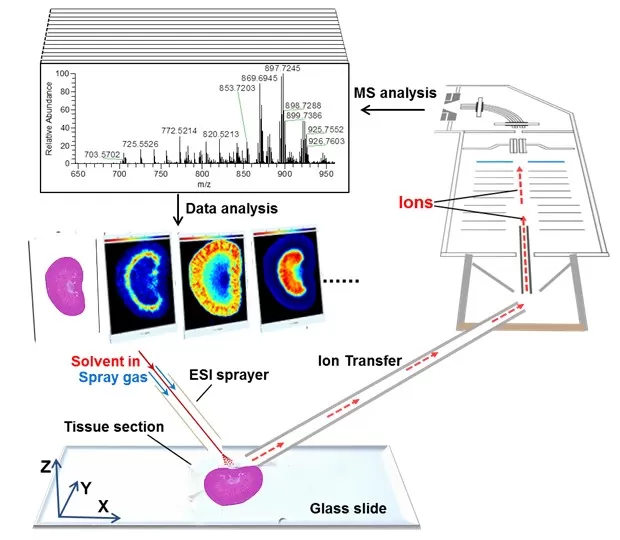Spatial Metabolomics Based on Mass Spectrometry Imaging: Mapping Molecular Landscape
From "Blind Boxes" to High-Definition Metabolic Maps
Traditional metabolomics analyzes homogenized tissue samples, providing a bulk overview of metabolites but sacrificing critical spatial information. Imagine dismantling a complex jigsaw puzzle—once the pieces are scrambled, reconstructing the original image becomes nearly impossible. Similarly, blending tissues into a "soup" erases the intricate molecular architecture of organs, tumors, or plant structures. Enter spatial metabolomics, a revolutionary approach integrating mass spectrometry (MS) with molecular imaging. This technology enables qualitative, quantitative, and spatial analysis of metabolites simultaneously, transforming our ability to map molecular distributions in tissues at resolutions as fine as 5 µm (subcellular level). For instance, in cancer research, spatial metabolomics has revealed how lipid gradients in tumors correlate with drug resistance—a discovery impossible with conventional methods. This paradigm shift is not just a technical upgrade; it redefines how we study disease mechanisms, drug distribution, and even plant-environment interactions.

Spatial metabolomics map molecular distributions
Technical Principles: How Mass Spectrometry Imaging "Paints" Molecular Landscapes
Core Workflow: The process begins with ionization, where a laser or ion beam (e.g., Matrix-Assisted Laser Desorption/Ionization, MALDI) excites molecules on the tissue surface, generating charged ions. These ions are then separated in a mass spectrometer based on their mass-to-charge ratio (m/z) while their spatial coordinates are recorded. Finally, specialized software reconstructs the data into 2D or 3D molecular distribution maps. For example, MALDI-MSI can visualize neurotransmitters in brain slices or trace anticancer drugs within tumor microenvironments, all without destroying the sample.
Unique Advantages: 1) Label-Free Analysis: Unlike fluorescence-based techniques, spatial metabolomics requires no chemical tags or probes, eliminating artifacts from labeling and enabling direct detection of endogenous molecules. 2) High Throughput: A single experiment can profile thousands of metabolites, lipids, drugs, and environmental contaminants. Recent studies have mapped over 1,500 metabolites in plant roots under drought stress, uncovering spatial patterns linked to resilience mechanisms.

Spatial metabolomics workflow
Spatial Metabolomics Applications: Breakthroughs Across Disciplines
1. Cancer Research: Decoding Metabolic Rewiring
Tumors are metabolically heterogeneous ecosystems. Spatial metabolomics has exposed striking lipid accumulation zones in pancreatic cancer tissues, correlating with regions of immune evasion. In one landmark study, researchers tracked the uneven distribution of 5-fluorouracil (a chemotherapy drug) within liver tumors, explaining why some regions resist treatment. Such insights are guiding precision dosing strategies and novel drug delivery systems.
2. Neuroscience: Mapping Brain Chemistry
In Parkinson’s disease, spatial metabolomics identified a depletion of serotonin and 3-O-methyldopa in the parietal cortex—a finding that challenges traditional models of dopamine-centric pathology. By overlaying these metabolic maps with MRI data, scientists are unraveling how neurotransmitter imbalances propagate neurodegeneration.
Challenges and Future Directions in Spatial Metabolomics
Despite its transformative potential, spatial metabolomics faces two major hurdles. First, the detection of low-abundance metabolites—such as signaling lipids critical for cellular communication—remains challenging due to sensitivity limitations. Emerging technologies like MALDI-2, which enhances post-ionization efficiency, promise to amplify signal intensity by 10-100-fold, bridging this gap. Second, the sheer volume of data generated by mass spectrometry imaging (MSI) poses a computational bottleneck; a single experiment can produce terabyte-scale datasets. Conventional bioinformatics tools struggle with such complexity, driving the adoption of machine learning pipelines. For instance, neural networks trained on spectral libraries are now automating metabolite annotation and spatial clustering, significantly accelerating data interpretation.
The future of spatial metabolomics lies in pushing technological and analytical boundaries. Advancing toward single-cell resolution (beyond the current 5-µm limit) will unravel metabolic heterogeneity among individual cells, offering insights into cancer stem cell niches or distinct neuronal subtypes. Simultaneously, integrating spatial metabolomics with transcriptomics and proteomics is paving the way for 4D multi-omics atlases that map "gene-metabolite-function" networks across space and time. Early successes include correlating lipid distribution patterns with spatially resolved RNA-seq data in breast cancer, which has already uncovered novel therapeutic targets. These innovations promise to transform precision medicine by linking molecular geography to disease mechanisms and treatment responses.
Unlocking the Spatial Dimension of Precision Medicine
Spatial metabolomics is more than a technological leap—it’s a fundamental shift in how we perceive biological complexity. From exposing drug resistance "hotspots" in tumors to optimizing traditional herbal formulations, this field is decoding life’s molecular blueprints with unprecedented clarity. As resolution approaches single-cell scales and multi-omics integration matures, we stand on the brink of a new era: one where diseases are diagnosed not just by genomic mutations, but by dynamic, spatially organized metabolic ecosystems. The future of personalized medicine isn’t just precise; it’s ‘geographically intelligent’.
Read more
- Spatial Metabolomics: Transforming Biomedical and Agricultural Research
- Spatial Metabolomics Explained: How It Works and Its Role in Cancer Research
- MALDI, DESI, or SIMS? How to Choose the Best MSI Techniques for Spatial Metabolomics
- How to Prepare Samples for Spatial Metabolomics: The Essential Guide You Need
- Omics Data Analysis Series


